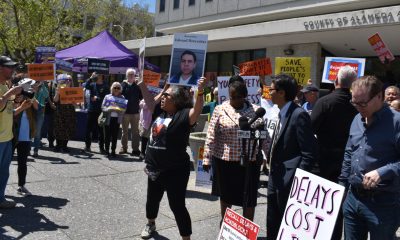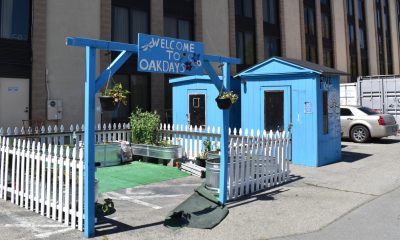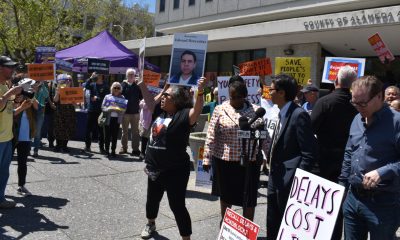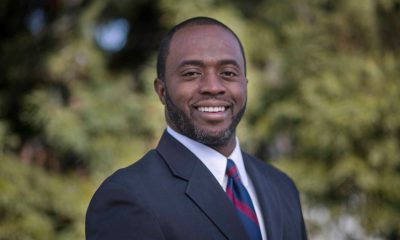City Government
Hospital Closures, Cuts in Services Loom for Some Communities. How the State May Step in to Help.
Five months after declaring a fiscal emergency and predicting that they’d run out of funds by early this year, officials at San Benito County’s only hospital said they have secured enough cash to get through the summer. At least for now, residents there won’t lose their local hospital.
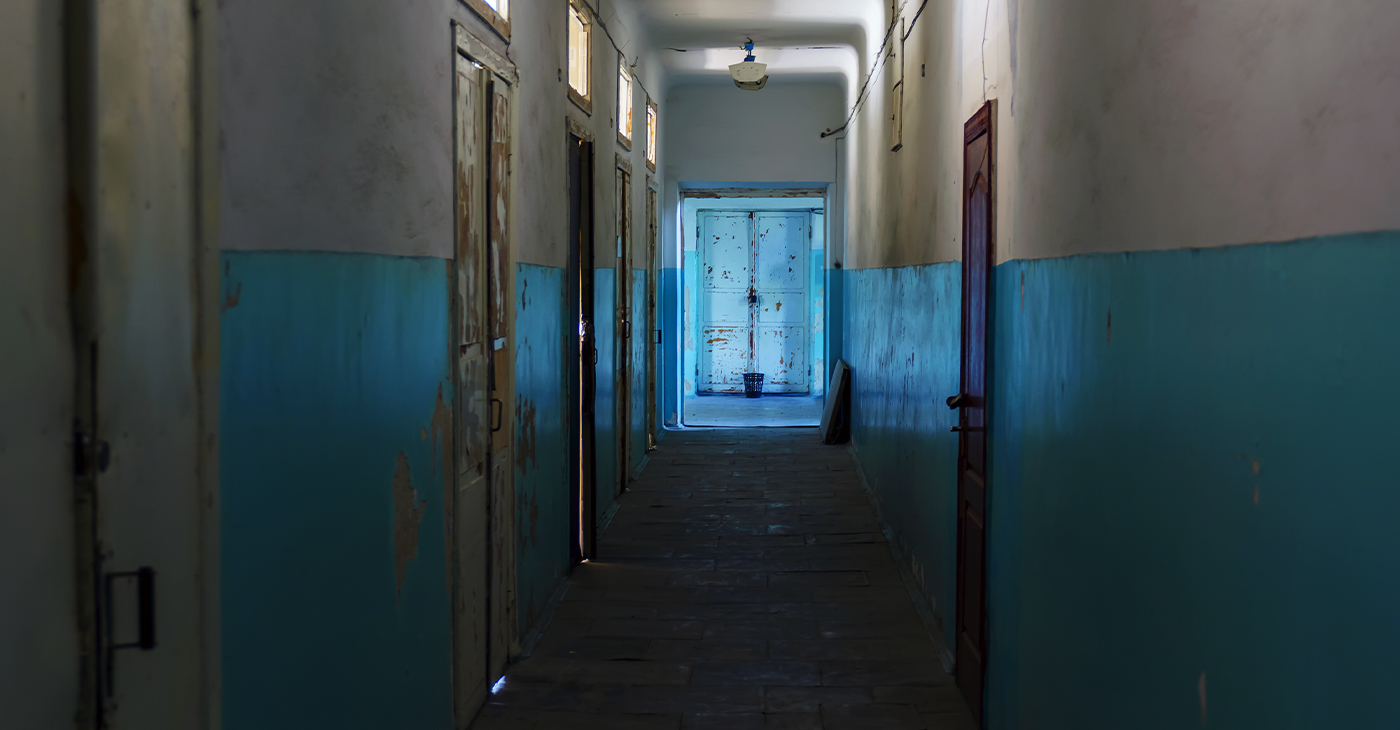
By Ana B. Ibarra
CalMatters
Five months after declaring a fiscal emergency and predicting that they’d run out of funds by early this year, officials at San Benito County’s only hospital said they have secured enough cash to get through the summer. At least for now, residents there won’t lose their local hospital.
But a short-term infusion of cash only buys Hazel Hawkins Memorial Hospital a little time. The end goal, hospital administrators say, is to find a buyer that will take over and not only keep the hospital solvent but, ideally, expand services in the area.
Hazel Hawkins, in Hollister, is one of a handful of hospitals statewide facing financial troubles. While some of these hospitals have encountered financial difficulties in the past, the closure of Madera Community Hospital, which shut down completely at the start of this year and filed for bankruptcy in March, has prompted a new cry for help. Now a group of legislators are brainstorming ways to support struggling hospitals and keep them from shutting down or cutting services.
Legislative proposals on the table include a bill that would offer emergency loans for hospitals facing closure or those trying to reopen. A second bill involves Medi-Cal, the health insurance program for low-income people. It proposes funneling more money to hospitals by boosting Medi-Cal payments to providers by reinstating a tax on health insurance plans.
In California, six rural hospitals are at heightened risk of closing, according to the Center for Healthcare Quality and Payment Reform. The center does not release the names of at-risk hospitals because a hospital’s situation can change quicker than data may reflect, said Harold Miller, the center’s president. The California Hospital Association said a few hospitals in metro areas are also struggling, but the organization has not publicly named every hospital it deems at risk, noting that when a hospital announces its perilous financial situation it can prematurely begin to lose workers and patients.
Among hospitals that have publicly talked about their troubles or attributed reductions in services and staff to their finances: Hazel Hawkins and Mad River Community Hospital in Arcata have both suspended their home health services programs; Kaweah Health Medical Center in Visalia has laid off at least 130 employees; El Centro Regional Medical Center in Imperial County cut its maternity ward, forcing local families to travel about 25 minutes to the only other hospital in the county.
Most recently, in mid-March, Beverly Hospital, a 202-bed hospital in Montebello, said that in June it will suspend its maternity, pediatric and outpatient radiology services. In a January letter to the state attorney general, the hospital noted its “dire financial circumstances” and said it would be canceling its plans to affiliate with the health care system Adventist Health because “Beverly Hospital does not have the resources to remain operational during the pendency of the attorney general review.” Under state law, the attorney general must approve the sale of nonprofit hospitals.
The California Hospital Association is asking for $1.5 billion from the state for struggling hospitals, and its request is being supported by a bipartisan group of lawmakers. But even supporters acknowledge this is a challenging request when the state is projecting a budget deficit.
Health economists interviewed by CalMatters said state help should be targeted so that any financial aid goes to hospitals in actual need.
“Most of the hospitals in California are in big systems and those systems have financial resources to get their members through. But there are a few that genuinely appear to be at risk if this cost surge continues,” said Glenn Melnick, a health economist at the University of Southern California. “The question is: Does the government want to have a facility that could get them (hospitals) through this rough patch? What you don’t want is to hand out a billion and half dollars to hospitals that may not need it.”
Providing aid to hospitals in trouble is warranted and different from helping other types of businesses because the goal is to protect patients, said Chris Whaley, a health economist with RAND Corp., a think tank.
“When businesses go out of business, even if it is no fault of their own, we accept that as part of capitalism, but in health care, if a hospital goes out of business that usually means a vulnerable patient population has lost access to care,” he said.
Saving Hollister’s hospital
Hospitals have largely blamed the pandemic for their financial troubles. They’re still recovering from increased expenses related to labor, drugs, and medical supplies needed to respond to COVID-19. Struggling hospitals that have spoken about their circumstances have a couple of common threads: They are independent, meaning they don’t have the financial backing of a well-endowed health system, and at least a third of their patients are low-income and insured through Medi-Cal.
Some hospitals face additional pressures. For example, despite its increased expenses, Hazel Hawkins, a 25-bed hospital, posted earnings of $2.6 million in the fiscal year that ended in June of 2022, according to state financial documents. Then in July it learned that it was being overpaid by Medicare, the federal insurance program for seniors and people with disabilities, said Mary Casillas, Hazel Hawkins’ interim CEO. The hospital is now on the hook to repay more than $5 million to Medicare. That’s on top of a 20% decrease in its adjusted Medicare reimbursement, she said. By December, employees had received notices of a potential closure.
Earlier this year, the hospital secured a $3 million state loan, received an advancement in property tax dollars it receives from the county and has been working to reduce its operational costs. That, among other efforts, will help the hospital stay afloat at least until September and give it time to find a buyer, Casillas said. She said her hospital has been approached by at least 10 interested parties that are currently reviewing Hazel Hawkins’ situation.
“We have bankruptcy professionals, as well as financial advisors, who have been very helpful at helping us manage our cash flow,” Casillas said.
Legislators’ proposals
Assemblymember Esmeralda Soria, a Fresno Democrat whose district includes Madera and who is authoring legislation, said keeping hospitals open is not optional — people should have emergency care close to home.
“I think this issue is really important as the state continues to pursue expansion of coverage. This is a reminder that folks in my area may qualify for Medi-Cal, but what does that mean if they can’t access care?” Soria said.
Soria is authoring Assembly Bill 412, the legislation that would create an emergency loan program specifically for hospitals that are facing closure or that have closed but have a plan to reopen. Currently, state loans are only available to operating public hospitals, but Soria wants to create an option that would aid the reopening of Madera Community Hospital. In the case of a closed facility, the loan would be made to a government entity looking to reopen its local hospital.
The legislation would require a budget allocation of $20 million, which would be added to funds already available through the state treasurer’s office. These additional loans would likely be a very small part of the puzzle. In Madera, county officials have estimated that it would cost about $55 million to reopen the hospital.
Long term, legislators are eyeing more ambitious ideas. For example, Soria said an ideal scenario would be for the University of California system to take over the defunct Madera hospital. The UC could run a medical residency program there, which would help attract more providers to the San Joaquin Valley.
“We’ve approached UC Merced,” Soria said, noting that those conversations are very new. “Is it a possibility to dream big and have the UC take it over? I think there are opportunities like this, and we have to think outside the box.”
Meanwhile, Sen. Anna Caballero, a Merced Democrat, has introduced Senate Bill 870, which calls for the state to renew a tax on managed care organizations that expired last year, and use some of those funds to increase payments to hospitals and other providers. Higher payment could provide some relief to hospitals that serve a large low-income patient population, Caballero said.
Medi-Cal rates, providers argue, have not kept up with growing costs. The California Hospital Association estimates the state pays hospitals 74 cents for every dollar spent on a Medi-Cal patient. Experts point out that hospitals also receive “supplemental payments,” which include payments to hospitals that serve a disproportionate share of Medi-Cal patients and compensation for care provided to uninsured people. In 2021, California hospitals altogether received about $9.2 billion in these supplemental payments, according to the Medicaid and Children’s Health Insurance Program Payment and Access Commission.
In an email, the hospital association said supplemental payments do not make up for the shortfalls in base pay. “The structural funding problem is the result of base payment rates that haven’t increased in over a decade, despite massive inflationary growth,” said David Simon, a spokesperson for the association.
Gov. Gavin Newsom also called for the reinstatement of the tax on managed care organizations in his January budget draft. His proposal points more toward sustainability and offsetting any potential cuts in Medi-Cal, rather than expanding service levels and provider payments. Typically, revenue from that tax allows the state to save general fund spending on Medi-Cal. If reinstated, revenue from this tax could save the state’s general fund up to $2 billion a year, according to the Legislative Analyst’s Office.
Caballero said that providing aid to hospitals should come with some scrutiny. Part of what legislators are working on in these proposals is the criteria hospitals will have to meet in order to be eligible for state resources, she said. One idea is to send a team of experts that analyzes each hospital’s situation, and if part of the problem is mismanagement, then there would have to be changes in the hospital’s leadership as a condition to receive help, she said.
The Republican Senate caucus, led by Sen. Brian Jones, a San Diego Republican, is taking a different approach and pegging its legislation, Senate Bill 774, to the state attorney general’s authority over hospital transactions. By state law, the attorney general has to review and approve mergers that include a nonprofit hospital as a way to examine a buyer’s market power and ensure protections for patients.
Trinity Health, a nonprofit Catholic health care system, was set to purchase Madera Community Hospital but pulled out of the deal, blaming conditions imposed by Attorney General Rob Bonta. Jones’ bill seeks to prohibit the attorney general from requiring certain conditions, like restricting the buyer from negotiating new contracts and rates with payers.
Assembly Bill 869, by Assemblymember Jim Wood, a Democrat from Healdsburg, would benefit small and rural hospitals by providing relief in a different way. This bill would provide grants for seismic retrofitting to financially distressed hospitals and allow them more time to meet the state’s 2030 seismic standards. The requirements, which have been delayed in the past, have been a point of contention. State law requires that hospitals upgrade their buildings so that they are functional after an earthquake, but hospital leaders say they can’t afford the expensive upgrades, especially in their current financial situation.
“The bill is a targeted approach to preserve a small number of hospitals that are most often a community’s only access to emergency care,” Wood said during a recent Assembly Health Committee hearing, “and will certainly close if some relief is not provided.”
Activism
S.F. Black Leaders Rally to Protest, Discuss ‘Epidemic’ of Racial Slurs Against Black Students in SF Public School System
Parents at the meeting spoke of their children as no longer feeling safe in school because of bullying and discrimination. Parents also said that reported incidents such as racial slurs and intimidation are not dealt with to their satisfaction and feel ignored.

By Carla Thomas
San Francisco’s Third Baptist Church hosted a rally and meeting Sunday to discuss hatred toward African American students of the San Francisco Unified School District (SFUSD).
Rev. Amos C. Brown, president of the San Francisco NAACP and pastor of Third Baptist Church, along with leadership from local civil rights groups, the city’s faith-based community and Black community leadership convened at the church.
“There has been an epidemic of racial slurs and mistreatment of Black children in our public schools in the city,” said Brown. “This will not be tolerated.”
According to civil rights advocate Mattie Scott, students from elementary to high school have reported an extraordinary amount of racial slurs directed at them.
“There is a surge of overt racism in the schools, and our children should not be subjected to this,” said Scott. “Students are in school to learn, develop, and grow, not be hated on,” said Scott. “The parents of the children feel they have not received the support necessary to protect their children.”
Attendees were briefed last Friday in a meeting with SFUSD Superintendent Dr. Matt Wayne.
SFUSD states that their policies protect children and they are not at liberty to publicly discuss the issues to protect the children’s privacy.
Parents at the meeting spoke of their children as no longer feeling safe in school because of bullying and discrimination. Parents also said that reported incidents such as racial slurs and intimidation are not dealt with to their satisfaction and feel ignored.
Some parents said they have removed their students from school while other parents and community leaders called on the removal of the SFUSD superintendent, the firing of certain school principals and the need for more supportive school board members.
Community advocates discussed boycotting the schools and creating Freedom Schools led by Black leaders and educators, reassuring parents that their child’s wellbeing and education are the highest priority and youth are not to be disrupted by racism or policies that don’t support them.
Virginia Marshall, chair of the San Francisco NAACP’s education committee, offered encouragement to the parents and students in attendance while also announcing an upcoming May 14 school board meeting to demand accountability over their mistreatment.
“I’m urging anyone that cares about our students to pack the May 14 school board meeting,” said Marshall.
This resource was supported in whole or in part by funding provided by the State of California, administered by the California State Library via California Black Media as part of the Stop the Hate Program. The program is supported by partnership with California Department of Social Services and the California Commission on Asian and Pacific Islander American Affairs as part of the Stop the Hate program. To report a hate incident or hate crime and get support, go to CA vs Hate.
Bay Area
Mayor London Breed: State Awards San Francisco Over $37M for Affordable Housing
On April 30, Mayor London N. Breed announced San Francisco has been awarded more than $37.9 million in funding from the California Department of Housing and Community Development (HCD) as part of the State’s Multifamily Housing Program (MHP). The HCD loan will provide the final funding necessary for development of Casa Adelante – 1515 South Van Ness, a 168-unit affordable housing project located in San Francisco’s Mission District.

By Oakland Post Staff
On April 30, Mayor London N. Breed announced San Francisco has been awarded more than $37.9 million in funding from the California Department of Housing and Community Development (HCD) as part of the State’s Multifamily Housing Program (MHP).
The HCD loan will provide the final funding necessary for development of Casa Adelante – 1515 South Van Ness, a 168-unit affordable housing project located in San Francisco’s Mission District.
The new development at 1515 South Van Ness Ave. will provide 168 affordable homes to low-income families, formerly homeless families, and persons living with HIV earning between 25-80% of the San Francisco Area Median Income (AMI).
In addition, the project is anticipated to provide family-friendly amenities and ground floor community-serving commercial spaces that preserve the prevailing neighborhood character of the Calle 24 Latino Cultural District.
“This funding unlocks our ability to move on building affordable housing units for families in San Francisco at a crucial time. We understand the level of need for more housing that is accessible, and like the state, the city continues to face a challenging budget cycle,” said Breed. “1515 South Van Ness is a good example of what can be achieved in San Francisco when you have strong community partnerships and an unwavering commitment to deliver on critical needs for our residents.”
“From the beginning of my term as Supervisor, I have fought to bring affordable housing to 1515 South Van Ness” said Supervisor Hillary Ronen. “In the interim, the site has been utilized for homeless services and shelter, and I am thrilled that HCD has recognized the value of this development, and we are finally ready to break ground and bring 168 affordable homes to low income and formerly homeless families in the Mission.”
Owned and occupied by McMillan Electric Company until 2015, the City and County of San Francisco purchased 1515 South Van Ness Avenue in June 2019 with the intent of developing new affordable housing.
In November 2020, the San Francisco Mayor’s Office of Housing and Community Development (MOHCD) released a Multi-site Request for Qualifications (RFQ) seeking qualified developers to build affordable housing on the site, and subsequently selected Chinatown Community Development Corporation (CCDC) and Mission Economic Development Agency (MEDA) in May 2021 to develop the site.
The project is expected to begin construction in winter 2025.
“A strong, long-term push by Mission advocates to make this site 100% affordable is now paying off, with 168 family units that include services and childcare. People of color communities know what they need, and we are excited to be in partnership with a team, consisting of MEDA, CCDC, and MOHCD, that listens,” said Malcolm Yeung, Executive Director at CCDC.
“We are excited to be in partnership with CCDC, yet again, and for the opportunity to develop intergenerational affordable housing in the City’s Mission District,” said Luis Granados, executive director at MEDA.
Increasing housing affordable to lower-income and vulnerable residents is a key priority in the City’s Housing Element which calls for additional funding for affordable housing production and preservation, as well as Mayor Breed’s Housing for All Executive Directive that sets out the steps the City will take to meet the bold goal of allowing for 82,000 new homes to be built over the next eight years.
Tuesday’s funding announcement emphasizes the importance of regional and state collaboration in order to reach our housing and climate goals.
“We are thrilled—not just to bring a project of this size to a community with great need — but to do so with community-based developers and their partners who understand the neighborhood and sensitivities around cultural preservation,” said HCD Director Gustavo Velasquez.
City Government
Vallejo Continues to Accept Applications for Boards, Committees and Commissions
The City of Vallejo is requesting applications to serve on a number of the City’s boards and commissions. Vallejo residents who are interested in serving on an advisory body are invited to submit an application and supplemental questionnaire for consideration.
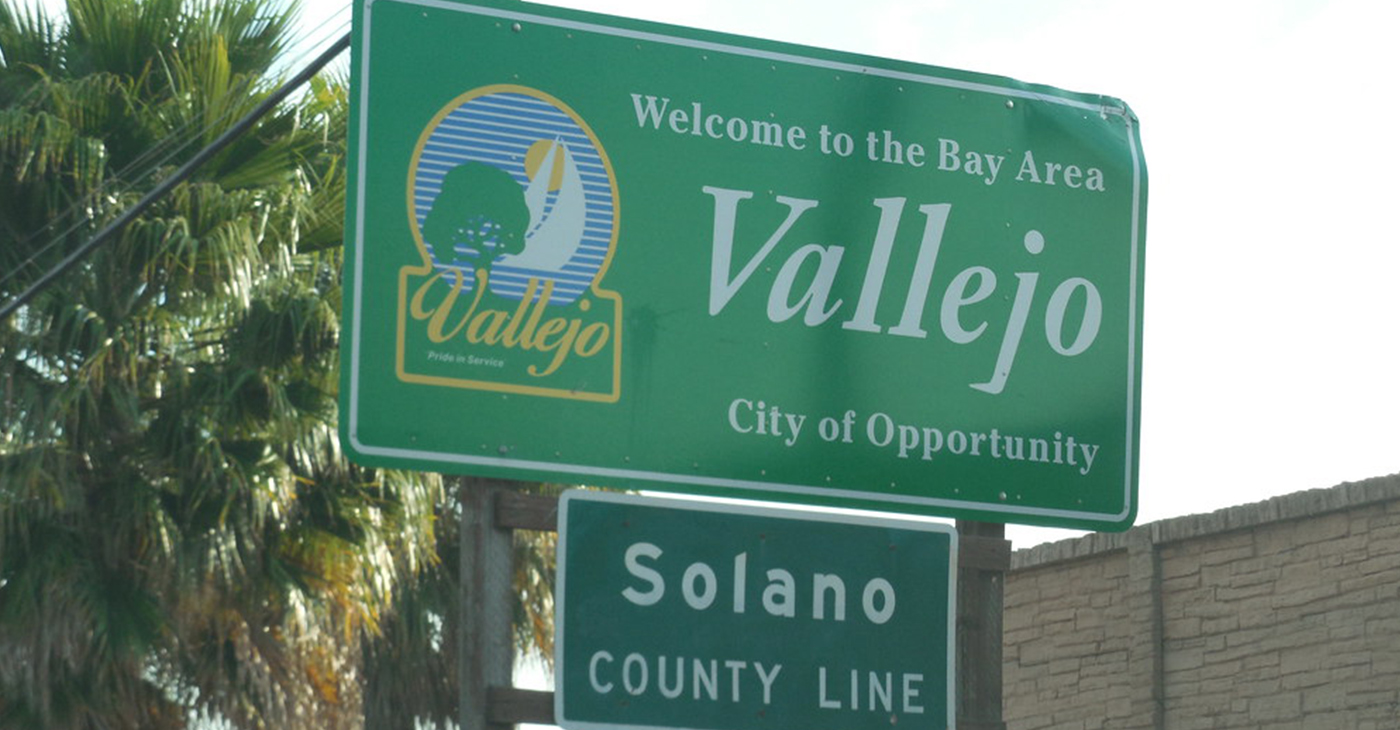
By City of Vallejo
The City of Vallejo is requesting applications to serve on a number of the City’s boards and commissions. Vallejo residents who are interested in serving on an advisory body are invited to submit an application and supplemental questionnaire for consideration.
There are currently openings on the following boards, commissions, and committees:
- Beautification Commission(2) terms expire 6/30/28
- Civil Service Commission(2) terms to expire 6/30/28
- Design Review Board(2) terms to expire 6/30/28
- Housing & Community Development Commission(1) term to expire 6/30/28
- Housing Authority(1) tenant commissioner term to expire 12/31/24
- McCune Collection Commission(3) terms to expire 6/30/28
- Participatory Budget Steering Committee(6 members & 3 alternates) terms expire 6/30/25
- Planning Commission(2) terms to expire 6/30/28
- Surveillance Advisory Board – Districts 1, 2, and 3 Members OnlyDistricts 1 & 3 terms to expire 1/2/25 and District 2 term to expire 1/5/27
- Sister City Commission(1) term to expire 6/30/27
- Solano Commission for Women & Girls(1) Vallejo representative can be youth or adult. Term to expire 4 years from date of appointment
For City Boards and Commissions, except for the Civil Service, McCune Collection, and Sister City Commissions, the Surveillance Advisory Board, and the Participatory Budgeting Steering Committee, all appointed members must complete and file a Statement of Economic Interests, Form 700, within 30 days of appointment.
All City Board and Commission members must complete AB 1234 Ethics training and file a Certificate of Completion within 30 days of appointment.
In most instances, to be eligible for appointment, applicants must be residents of the City of Vallejo. Information regarding the duties of each board and commission and specific criteria for appointment may be found within each application. With some exceptions, appointments are typically for a term of four years.
The application period will remain open until a sufficient number have been received in the City Clerk’s Office
Interviews with the City Council are tentatively scheduled for the evenings of June 3 and 10. Applicants must attend the interview to be considered for appointment on a board or commission.
Application forms and supplemental questionnaires are accessible in several ways:
- The City’s website, located on the Boards and Commissions page
- At City Hall, Office of the City Clerk, 555 Santa Clara Street, 3rd Floor, Vallejo, CA
- By Email at abrahamson@cityofvallejo.net, or by phone at (707) 648-4527
By U.S. Mail: City of Vallejo, C/O City Clerk, PO Box 3068, Vallejo, CA 94590
-

 Community3 weeks ago
Community3 weeks agoFinancial Assistance Bill for Descendants of Enslaved Persons to Help Them Purchase, Own, or Maintain a Home
-

 Business3 weeks ago
Business3 weeks agoV.P. Kamala Harris: Americans With Criminal Records Will Soon Be Eligible for SBA Loans
-

 Activism4 weeks ago
Activism4 weeks agoOakland Post: Week of April 10 – 16, 2024
-

 Community3 weeks ago
Community3 weeks agoAG Bonta Says Oakland School Leaders Should Comply with State Laws to Avoid ‘Disparate Harm’ When Closing or Merging Schools
-

 Activism2 weeks ago
Activism2 weeks agoOakland Post: Week of April 24 – 30, 2024
-

 Community2 weeks ago
Community2 weeks agoRichmond Nonprofit Helps Ex-Felons Get Back on Their Feet
-

 Community2 weeks ago
Community2 weeks agoOakland WNBA Player to be Inducted Into Hall of Fame
-

 Community2 weeks ago
Community2 weeks agoRPAL to Rename Technology Center for Retired Police Captain Arthur Lee Johnson

